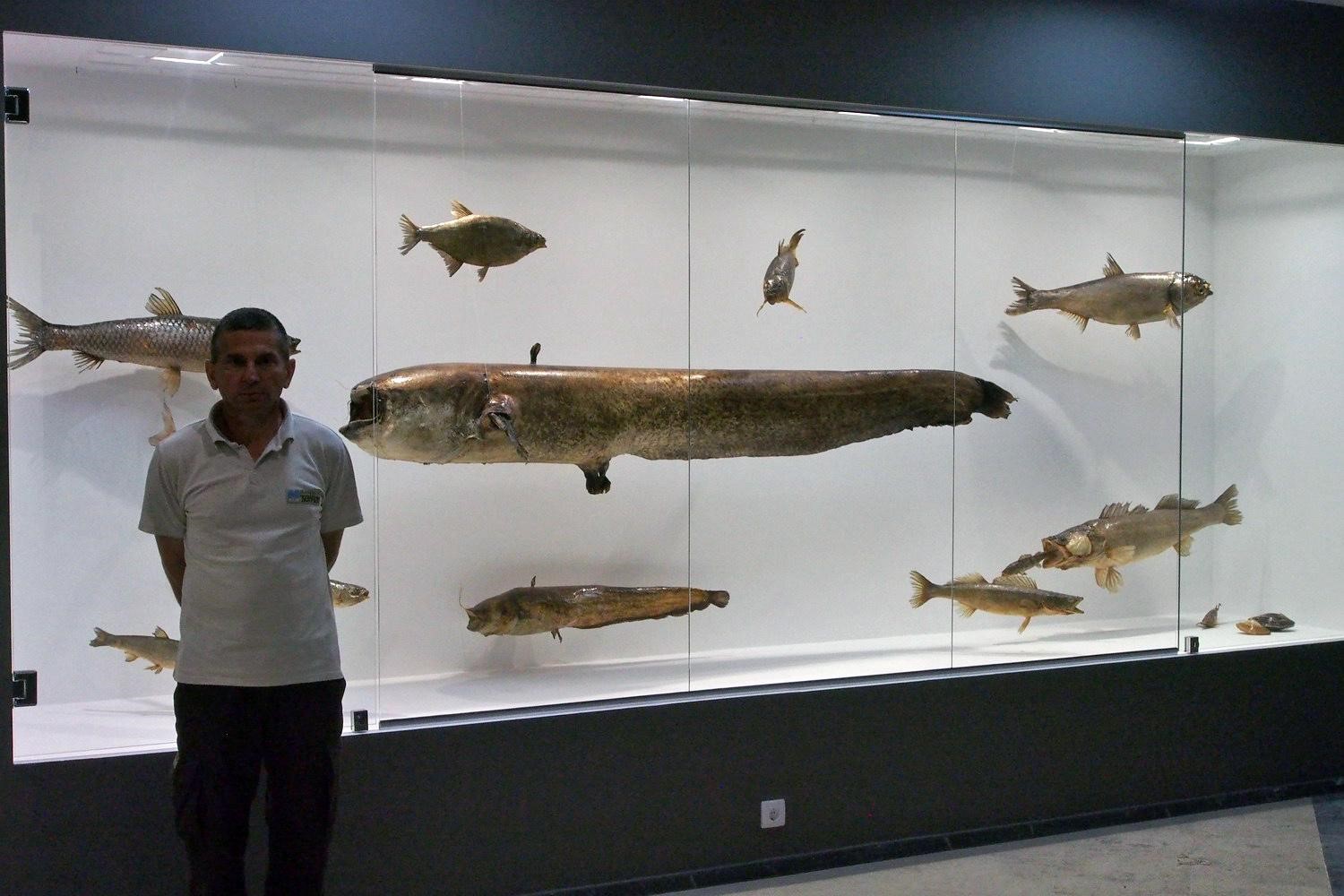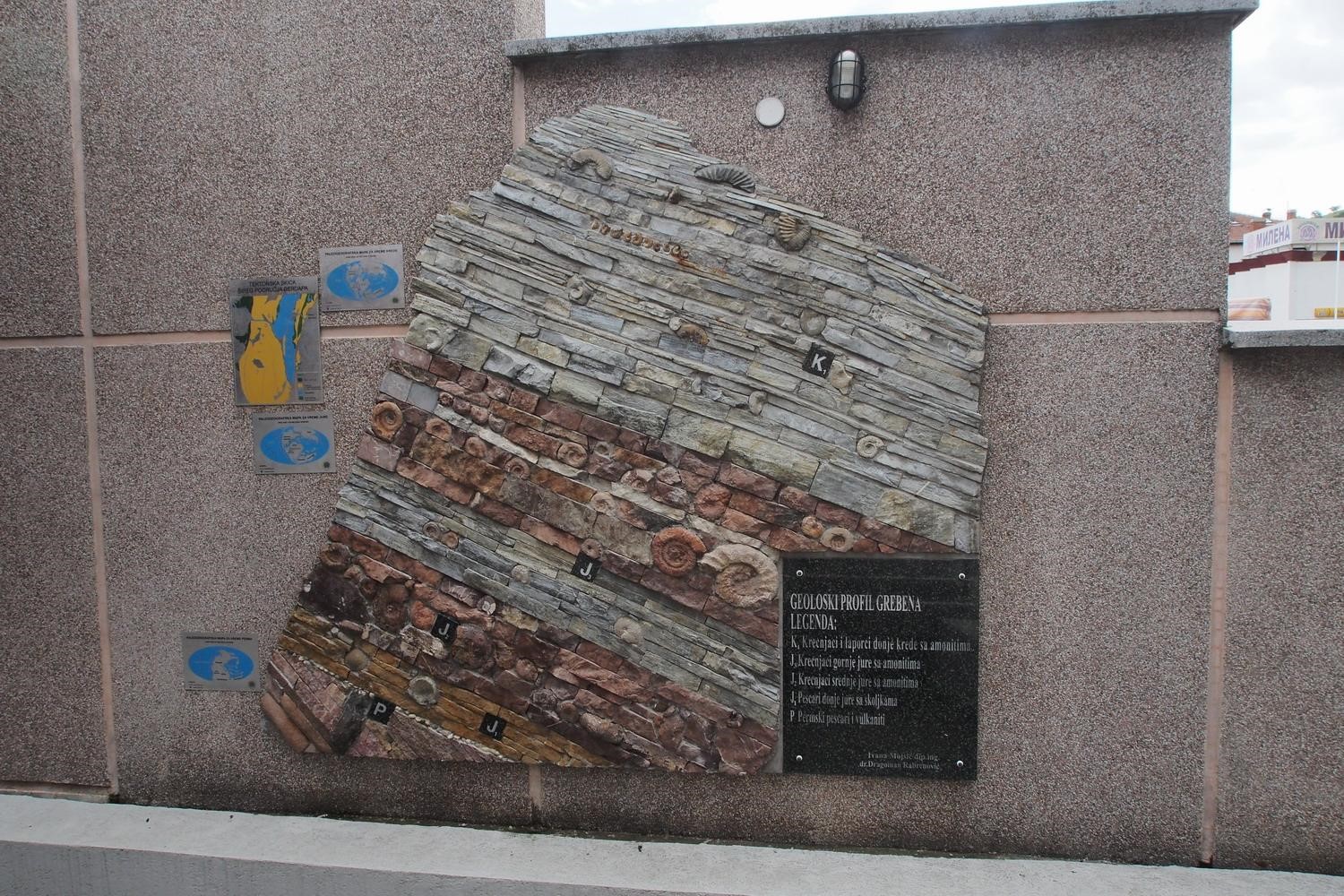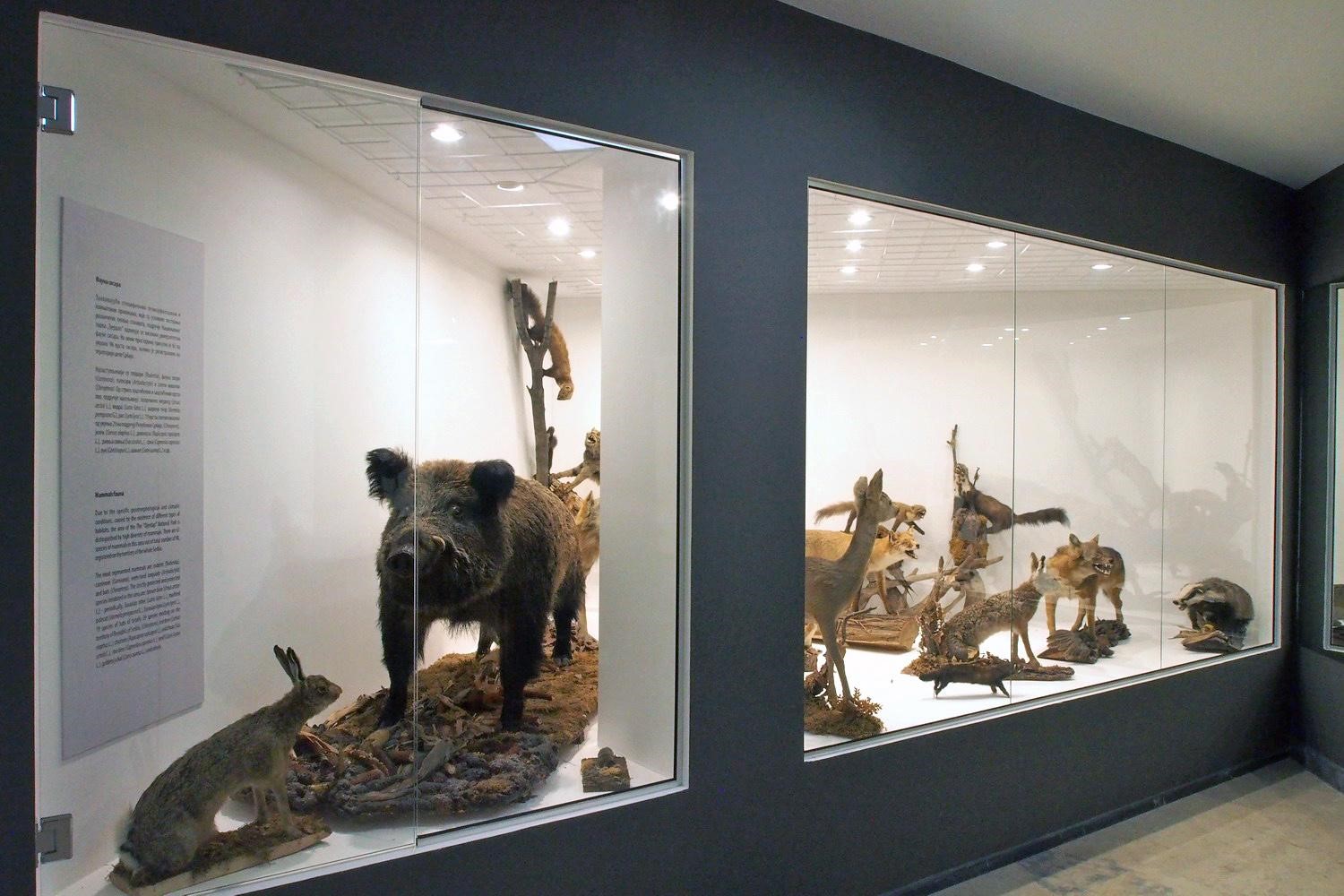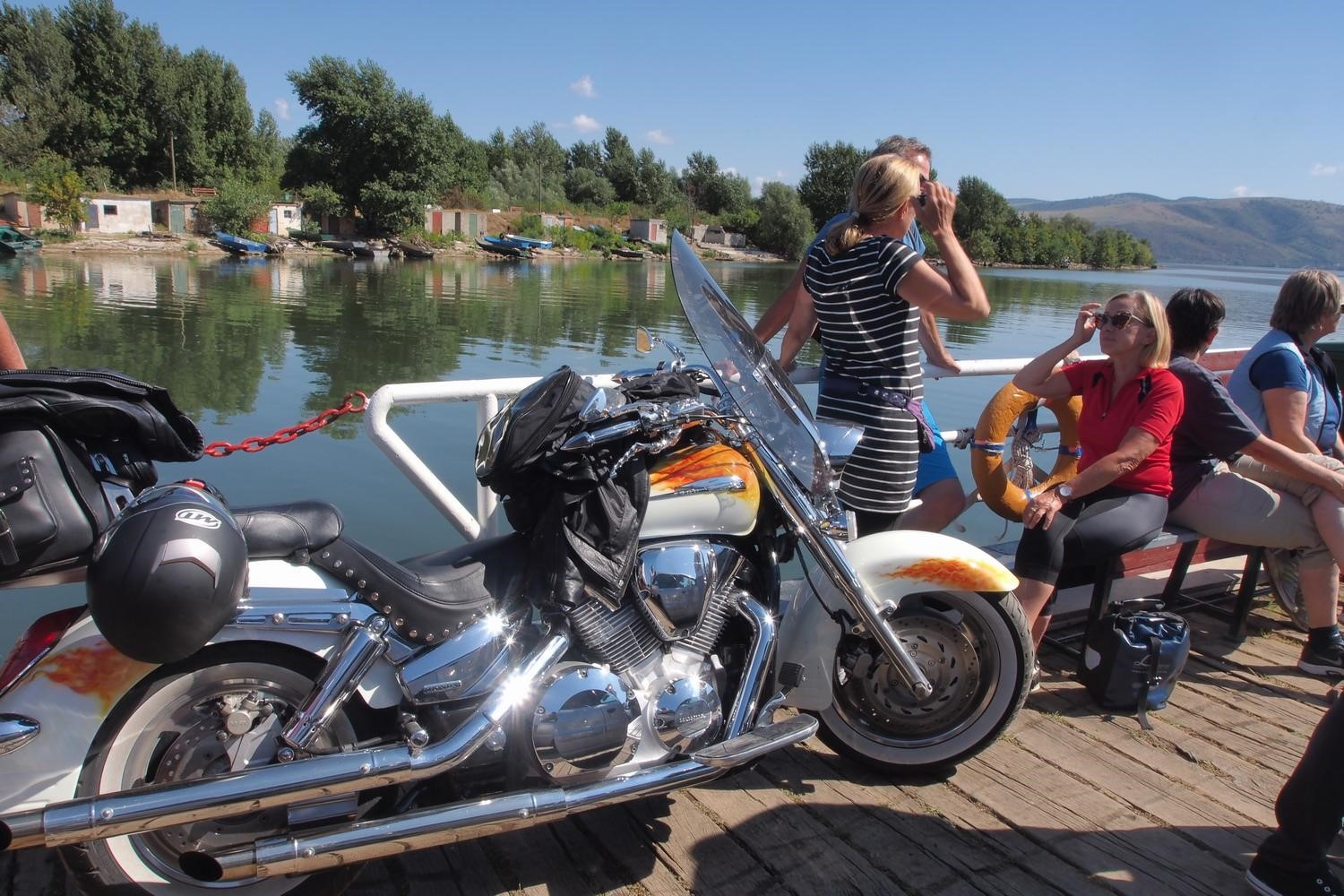|
A visit to Djerdap, i.e. the Serbian side of the Iron Gates, should begin in Donji Milnovac, a small town located right in the middle of 120 km long gorge that is also the National Park.

In the Iron gates gorge


Ready for all opportunities: a German cyclist on the EuroVelo 6,
with folding bike and an inflatable canoe in the trailer
I did exactly that, and my first interviewee was Mr. Goran Zikić, a Hunting and Fishing expert of the Park.
The first thing to know about the Park?
"The area of the Park is 64,000 ha. It stretches along the Danube at 120 km in length, from the small town Golubac to the small town Kladovo.”

Mr. Goran Zikić…

…and a moment when I truly realized
that catfish is actually just a sack with a hole at both ends

The essence of life
And there is the (in)famous Power Plant…
“The Hydroelectric Power Plant Djerdap I was constructed in the early 1970s and it raised the Danube at the location by 32 m. The lake extends to the mouth of the Nere but the slowdown of water is felt all the way to Slankamen in Vojvodina!
So the consequences were…?
The dam has cut the migratory paths of sturgeon species and changed the structure of the fish stock- The bottom of the river became muddy so some species disappeared (linjak/Tinca tinca, redfish), the number of barbels (Barbus barbus) decreased drastically, while the Golden-eyed pike (Esox lucius) was reduced to a negligible number. New, invasive species of fish have emerged - gray and white silver carp, amur, babuska, cverglan, gobies (Aphia minuta and Crystalogobius linearis), topmouth gudgeon.
Before WW II, no one took care of where these species spawn. In 2010, a sturgeon with a chip from Hungary was caught here. The hydroelectric plant at the time of construction assumed the obligation to build a hatchery on the Serbian side. For this purpose, large ponds were built in front of the village of Kostol (a few km downstream of Kladovo), but they were never put into an actual operation.

The brand new exhibition of the Djerdap National Park values

Fifteen years ago, a local initiative led to the opening of a commercial sturgeon farm. The fish were caught near the village of Radujevac, below HPP Djerdap 2, and transferred to the breeding farm with the idea of producing caviar (in the times before the dam was built, the caviar caviar was of better quality than the Russian one). But 10 years ago a ban on hunting morons was passed, and this business failed.
The Serbian Ministry of Energy so far keeps denying any talks on the construction of a sturgeon elevator, even on condition that the money is provided from abroad. (In Serbia, one such lift already exists at a hydroelectric plant on Lake Bajina Basta, near the border with Bosnia.) "

I was very fortunate to find in the local tributaries of the Danube a subspecies of brown trout found in only a few more rivers of Eastern Serbia. The genetic determination determined it to be a special species. In 2012-2014, special researches were conducted, on the basis of which the doctoral dissertation was written. "

I must admit that after speaking with my next interlocutor - Mr. Dr. Nenad Radaković, Director of the Park – I was left in quite a shock: nowhere on the Danube have I been served such a package of depressing facts. And I thought I knew a lot about this area…

Mr. Nenad Radaković, Director of the Park
"Sludging is a significant problem in the river here. The Djerdap Gorge is the collector of the Europe. The sludge can be cleaned but the question is what to do with it then because it contains cyanide (which got into Danube after past leaks in some Romanian mines), arsenic (from another mine). After the NATO bombing, they were joined by radioactive waste from that was washed off from bombed surfaces, as well by (proven carcinogenic) pyrene released when transformer oil from big electric power stations of Novi Sad were hit and set in fire. There are also fertilizers from the endless fields of Vojvodina, as well as various "ordinary" garbage. The largest deposits of slugde are near Golubac, where the Danube is the widest (6 km from Serbian to Romanian bank); here, tailings from the Romanian copper mine in the hill above the river pollute the entire riverside all the way to the small town of Veliko Gradiste, on the Serbian side.
And we are supposed to call this… "sludging"? Looks like quite a euphemistic name for what you said! But how does the... sludging affect the fish - and how does it affect the people who eat the fish ??
There are still professional fishermen (so-called “alas”) on the Danube in Serbia, and so is in Djerdap. They deliver fish to the table. In 2012-2013, in cooperation with the Institute from Serbian town Kraljevo, a survey was conducted on the amount of heavy metals on water, sludge and in skin and bones of fish. It was stated that the fish did not contain unacceptable quantities and did not contain mercury at all.
How is it possible that fish living and swimming above the deadly sludge is not dangerous to eat??
The explanation is that the dangerous layer of sludge has sunk deeper to the bottom - now it is at depths of 50 cm and more, and is insulated by new layers of sludge.
If that is true, another way to look at it is still that there was a period of several years (a decade…?) after the bombing when the poisonous sludge was in direct contact with water. And people still used to eat fish at that time?
In Donji Milanovac, where this National Park Directorate is also located, the treated water from the Danube has been used for drinking in the last 5-6 years. The advice is: don't drink it.
The measured quantities of some elements are than 100 to 1000 times above than allowed ones. Before switching to this water source, the city was supplied with drinking water from the nearby Poreč River, coming from the hilly region above the city. But the river runs through the Bor mine area on the South where copper and gold are extracted and processed. The tailings of these processes are very toxic, so even at that time the water from town plumbing was not used for drinking: the citizens of Milanovac have long been accustomed to using it only for technical purposes.

At the Exhibition entrance: all geological layers of the gorge in a glance
Well, are there other bad news here?
On the Romanian side, several years ago wind generators were installed at the entrance to the Djerdap Gorge, which disturb birds.
Our relations with the HE Power plant Djerdap I are not satisfactory. More specifically: we have no contact with them. They happen to suddenly and without any prior announcement open the dam gates and lower water level in the lake. Sometimes two meters, and during the night, and during full spawning time of the fish. This off course causes serious damage and the consequences are felt even two years after such events. In 2004, we had a large fishing mortality for exactly this reason. We regularly reported such incidents to state inspectors, but to no avail: HE Power Plants Djerdap I and Djerdap II are extremely important for supplying the country with electricity and the energy lobby is very strong. So they can allow to themselves to not care about cooperation with anyone locally, including the National Park.”
I must note here a special curiosity: Donji Milanovac does not receive electricity from HEPP Djerdap I, but from a thermal power plant in remote Kostolac?
"They flooded everything, they destroyed a lot, and they don't even provide electricity to this region. They certainly have a large budget for nature conservation, but they do not have a professional staff, for that and hence there is no knowledge of how to use these funds in the right way. Collaborating with us would therefore be useful for them, but welll... As for the problems they cause, there is a rulebook for damages in fishing industry - but how do one determine damages when it comes to fish eggs?”

This was depressing – let’s go to “normal” problems
There is certain pretty constant problem, and that is ignorance - not only of visitors but also of locals - about the way Park works. It is a common opinion that the Park is financed by the State, but all national parks in Serbia are unfortunately public enterprises and have to earn money in order to survive and to be able to perform their basic job – the nature protection. We are engaged in commercial forestry in the zones with the 3rd degree of protection, and we are also involved in numerous international projects. But it would certainly be much better, and the final solution would be, to reorganize the status of the national parks in Serbia. The paintings in the Louvre are a treasure of humanity. To see them, we need to buy a ticket. It should be the same with natural treasures, that is with national parks, instead of forcing then to abstain from forestry, hunting or fishing. If the State says "wolves should no longer be hunted", then the State should also compensate for the damage done by wolves.
Another problem over the last 30 years is that the State has not yet purchased all the land that is in the zones with the first (highest) degree of protection. The user of some of such surfaces is the Army, while on other localities the ownership is private. The Pecka Bar locality was in the first level of protection and was owned by the Army. "Solution": this locality site is longer belongs to the first level of protection.

Before the dam was built navigation through the gorge was tricky and dangerous.
Devices like this one were showing to boats the right of way on very narrow parts.
Up: go. Down: stop and wait.
Could we now even advance to good things?
“Let's start it lightly :) with something that is fifty-fifty half in that sense. The general population decline in Eastern Serbia, including the Danube coast in this part of the country, is intensive. However, this is good for to the nature conservation: the number of forest systems increases, meadows give way to forests.
A great honor for the Park is the state's proposal to declare Djerdap NP as the first Geopark in the country. Geoparks near Serbia exist in Slovenia (Idrija), Croatia (Papuk), Hungary (Balaton) and Romania (Hateg), but there are none in Bulgaria, Macedonia and Albania.
We have a number of very interesting phytocoenoses (communities) here. Walnut, nettle tree ((Celtis australis, an autochthonous species) are outgrowths of a maritime Mediterranean climate, then sword hazel, oaks, ash and beech (Moesian), wild cherry and wild pear - all these plants are in Djerdap much larger than average. There is also yew here - it grows on vertical rocks, and we also have large-flowered anemone. There are 40-50 of autochthonous woody species. There are also natural arboretums where different types of trees grow side by side.
Bears sometimes flock to the Park - usually when the Danube freezes and they can cross over from Romania. Fishermen also reported on deer swimming across the Danube, apparently in search of quieter and safer zones.
And there are always legends and stories about surgeons. According to Brem, a sturgeon can grow up to 9 m and can weigh up to 1800 kg. Catfish is a decent replacement: one of the 2.1 m and 170 kg, was recently caught – and much bigger samples are part of fisherman history here. Jean Jacques Custo descended into the depths of the Danube in 1990 (up to 90 m below sea level!) and claimed to have seen huge catfish floating down there. But it should be emphasized that the ban on catfish fishing is currently in place.“

And thee is also the historic and cultural side
The prehistoric settlement of Lepenski Vir, one of the cradles of European civilization, was accidentally discovered during preparations for the construction of the HEPP Djerdap I dam. In 1601, Orbinius wrote the work "The Empire of the Slavs", stating that one of the founders of the Lepenski Vir could be Noah. The Lepenski vir dwellers were genetically very close to the present Slavic population.
There were several other confirmed archaeological sites i the gorge, but they were unfortunately submerged by lake water. Fossil rye and shark tooth fossil have also been found there.
It is amazing that nature has remained preserved until today, for such a long period of time and through the shifts of various civilizations. The main reason is probably the difficult accessibility of the terrain here. Unusual folk customs, food and costumes are also preserved.
How it looks like to work in a National Park that is established in such a complex area?
Working in the Park requires knowledge in many fields. In turn, these are hidden values that constantly delight.
I've been working at the Park for 23 years and what I've learned a long time ago is that generations of people are responsible for today's level and status of the Park. In recent decades, there has been a marked increase in the number of tourists and many of them want to get acquainted with the values of the Park. Tourist areas are formed on the basis of the Law on Tourism and are managed by two Limited Liability Companies: "Golubacki grad" and "Lepenski vir". Cooperation with these organizations is great, but they have 100,000 visitors a year and have no formal ties to the Park. We feel that we should be involved in this process too, but the Park has no representatives in the listed societies. No other NP or protected zone in Serbia has such a combination with commercial entities, but some lobbies were strong enough ten years ago to establish this system in cooperation with local municipalities and local self-administrations.
Let’s finish with some achievements and plans/ wishes for the future
In 2018, we opened a Visitor Center in the village of Tekija, 16 km upstream of the HEPP Djerdap I. Much work is also being done to mark the area with signposts, especially for pedestrians. In many places we also have new info boards with information about the values of the Park. We are planning a reintroduction of Djerdap
We plan reintroduction of the Djerdap tulip, as well as the reintroduction of the Griffon vulture (Gyps fulvus). There were about 56 of these birds here in the past, but they were killed during the times when wolves population was reduced by poisoning with strychnine.
There is a nice idea of establishing a Transboundary Biosphere Park, which would be great both in practical and symbolic terms (the river that connects instead of separating). But at the moment we do not have enough human resources to do such a thing. In the near future, some modest (but yet valuable) achievements will be procurement of tourist minibuses and boats, as well as of drones for terrain monitoring.
Until 1990, Donji Milanovac had a meteorological station and in that sense was part of the world. A Hundred years ago there were similar stations in Tekija and some other places. So today it would be good to have such tools - if not complete stations then at least rain gauges. (By the way, according to the data from former stations, Donji Milanovac was the sunniest place in the former Yugoslavia along the Adriatic island of Hvar.)
Success? For me it is, above all, the treasury preserved for future generations, and a boost of tourism at the same time. Of the current things, I would like to single out a new map of the Park as well as a new collection of promo and info- material. We also have a renovated exhibition which now looks really nice, and we don’t have to be ashamed of other parks.
Next I spoke with Mr. Zoran Milovanović, a biologist in the Park
The three monographs
“There were three important projects in 2010-2012, executed in collaboration with the Institute for Nature Conservation and the Ministry of the Environment. They resulted in three monographs. “

Mr. Zoran Milovanović


The first one lists all birds with particular emphasis on endangered species in the Djerdap area. There are 180 species listed there, out of 365 in total in Serbia. This publication was also used for Natura 2000 and it shows that the Djerdap is a very well-preserved habitat and hence for a reason declared as an Important Bird Area (IBA).
The Griffon Vulture (Gyps fulvus) exists in Serbia today only in the canyons of Uvac and Tresnjica, but it was present in a large numbers in Djerdap too, until 1948. Therefore, our desire to have him here again is understandable. Reintroduction is planned in cooperation with the Uvac Reserve. (Interestingly, the process starts by keeping the youngs in cages with a view of their future nesting site, until they are grown enough.)
We have three pairs (or three nests) of the Golden eagle (Aquila chrysaetos) and there are are also dwarf eagles (Aquila pomarina), gray falcons (Falco peregrinus), the mountain woodpeckers, and prdavac quails.
The second monograph was about cave bats, of which there are 15 species here.
“The third monograph was about speleological objects in the Park area. Designed in collaboration with the National Geographical Institute, it contains descriptions of 30 caves and pits.”

With a nugget in the belly - just digesting lunch.
I understood that you participated in the DANUBEparksCONNECTED project in the past?
“The Park took part in the first and second stage of the DANUBEparksCONNECTED project. In that frame I followed two bird species along the Danube banks in Serbia, from Ram to the mouth of the Timok (i.e.. Radujevac), in the total length of 240 km. The first one was the Little ringed plover (Charadrius dubius) and the second was the Sand martin (Riparia riparia). These two species are in fact indicators of habitat conservation, and the results were positive. A nice achievement, and It is a pity that the Park is not involved in present stages of the project.”
Your point of view of the Djerdap I dam influence is different from what I heard about the impoundment in the upstream countries?
“To my opinion as a biologist, the dam and the lake of HEPP Djerdap had a positive impact on the flora in the gorge. It was due to the increased humidity: a lake ecosystem and a wintering ground for birds were formed after the dam was built. But I won’t go into other aspects of the influence.”
There are some interesting particularities in the gorge?
„Definitely. For example. the normal distribution tree species with elevation is oak -> beech -> conifers. But here, on the shore at the locality "Hajdučka vodenica", we have the vegetation inversion - beech below oak.
The only naturally growing conifer in the Park is the yew that grows in Kazan, the narrowest part of the gorge, 100-150 m above the water. (We can nevertheless mention a planted pine tree forest in the village of Vinci.)
The Iron gates gorge climate allows the nettle tree (Celtis australis), which is a Mediterranean plant, to grow here as a relic from the Ice Age, during which the climate here was milder. Even today, all the way until the end of the gorge close to the HEPP Djerdap I dam/border crossing, we have the feeling that we are somewhere in the Mediterranean or in Macedonia, and then there is a sudden change...
One sad thing to mention: although the traffic on the gorge road is not that intense, large numbers of animals (especially of large and small mammals) are affected by it because it intersects their morning and evening lines of movement (towards water and from water). Sometimes when I drive to the office early in the morning it looks to me like a hart breaking slaughterhouse: roe deer, foxes, hedgehogs, badgers... The only solution would be to limit the speed to 40 km/h, which is difficult because this is the main road to Donji Milanovac and Kladovo towns.

On the ferry to the Iron Gates


|
